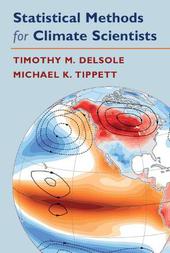
|
Statistical Methods for Climate Scientists
Hardback
Main Details
| Title |
Statistical Methods for Climate Scientists
|
| Authors and Contributors |
By (author) Timothy DelSole
|
|
By (author) Michael Tippett
|
| Physical Properties |
| Format:Hardback | | Pages:542 | | Dimensions(mm): Height 250,Width 173 |
|
| Category/Genre | Probability and statistics
Meteorology and climatology
Global warming |
|---|
| ISBN/Barcode |
9781108472418
|
| Classifications | Dewey:551.6015118 |
|---|
| Audience | | Professional & Vocational | |
|---|
| Illustrations |
Worked examples or Exercises
|
|
Publishing Details |
| Publisher |
Cambridge University Press
|
| Imprint |
Cambridge University Press
|
| Publication Date |
24 February 2022 |
| Publication Country |
United Kingdom
|
Description
A comprehensive introduction to the most commonly used statistical methods relevant in atmospheric, oceanic and climate sciences. Each method is described step-by-step using plain language, and illustrated with concrete examples, with relevant statistical and scientific concepts explained as needed. Particular attention is paid to nuances and pitfalls, with sufficient detail to enable the reader to write relevant code. Topics covered include hypothesis testing, time series analysis, linear regression, data assimilation, extreme value analysis, Principal Component Analysis, Canonical Correlation Analysis, Predictable Component Analysis, and Covariance Discriminant Analysis. The specific statistical challenges that arise in climate applications are also discussed, including model selection problems associated with Canonical Correlation Analysis, Predictable Component Analysis, and Covariance Discriminant Analysis. Requiring no previous background in statistics, this is a highly accessible textbook and reference for students and early-career researchers in the climate sciences.
Author Biography
Timothy M. DelSole is Professor in the Department of Atmospheric, Oceanic, and Earth Sciences, and Senior Scientist at the Center for Oceanic Atmospheric, and Land Studies, at George Mason University, Virginia. He has published over one hundred peer-reviewed papers in climate science and served as co-Editor-in-Chief of the Journal of Climate. Michael Tippett is an Associate Professor at Columbia University. His research includes forecasting El Nino and relating extreme weather (tornadoes and hurricanes) with climate, now and in the future. He analyzes data from computer models and weather observations to find patterns that improve understanding, facilitate prediction, and help manage risk.
Reviews'This text will be useful for teaching advanced undergraduates and graduate students about the applications of statistical methods to climate data analysis. It is filled with many relevant examples informed by the authors' long experience in the field. I am sure that I will frequently use it as a reference in the coming years for my own research.' Tom Hamill, National Oceanic and Atmospheric Administration 'This book is essential for any climate scientist and is ideally suited for an introductory graduate course in climate analysis. The material covered includes a comprehensive sample of classical and modern multi-variate techniques that are widely used in the peer-reviewed literature. The step-by-step examples are clearly based on years of hands-on teaching experience by the authors and are easily implementable and, importantly, highlight interpretation and limitations - a must for any climate analysist.' Ben Kirtman, University of Miami 'An appealing book written by outstanding authors, with basic to advanced topics in every chapter, including some unusual topics for a statistics book such as data assimilation and the most predictable modes. The iteration with several years of students to produce an understandable and logical text (which is formal and analytical in nature) is unique and worthy for consideration as a textbook for graduate courses or as refresher for any geophysical scientist.' Huug van den Dool, NOAA 'Includes both the mathematics and the intuition needed for climate data analysis.' Dennis L. Hartmann, University of Washington
|